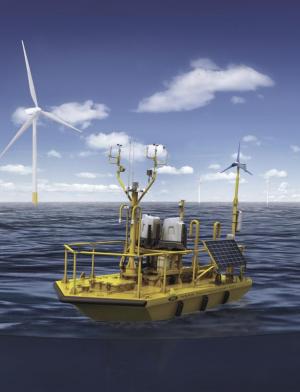Offshore wind farms, high-tech buoys: global meeting local
For boaters coming in and out of Roosevelt Inlet in Lewes, it’s tough to miss the research buoy sitting on the tarmac between the harbor operations building and the RV Hugh R. Sharp research vessel at the University of Delaware’s dock. The big yellow buoy, which looks more like a small barge, stands out even more in the gray light of winter days.
According to the university’s Director of Marine Operations Jon Swallow, the brightly colored aluminum research buoy is awaiting deployment to the Skipjack wind energy area about 14 miles off the Delaware coast, east of Rehoboth Beach.
It’s one more local ripple from the wind-energy industry being studied and planned in federally designated Bureau of Ocean Energy Management waters just off our coast.
Swallow said the research buoy, powered with small wind turbines, solar panels and rechargeable batteries, and festooned with automated scientific measuring equipment, arrived in Lewes from Baltimore in August for staging and deployment out of Lewes. But, said Swallow, the 18,000-pound buoy with its 10,000-pound concrete clump anchor is too heavy for deployment from the RV Sharp and will require a larger ship with a heavier-duty winch for deployment and ultimate recovery.
Swallow said Axys Technologies owns the buoy and wants to get it in the water soon. “It’s a weather buoy that collects all kinds of data to help inform the placement and size of wind turbines.”
In this context, the information gathered falls in the category of meteorological/oceanographic (met ocean) data.
This may be the same NOMAD buoy mentioned in a notice from the BOEM distributed in March. NOMAD stands for Naval Oceanographic Meteorological Automated Device, a class of research buoys that have been in use by the Navy since the 1940s. Axys’s buoys, of course, have been radically updated through the decades to reflect the latest measurement technology available to address the needs of clients like international wind farm firm Ørsted. That Denmark-based firm is working to get approvals necessary to develop the Skipjack project.
The BOEM notice advised that it studied and found no historic properties would be impacted by deployment of the research buoy. The notice indicated that the buoy is 20 feet long and 10 feet wide, would be moored by a 250-foot chain to a five-ton concrete clump anchor in 43.5 feet of water (5:1 scope for those readers who anchor now and then), creating a 3.3-acre area of impact from the anchor chain sweep.
Axys, a Canadian firm, markets its research buoys all over the world as environmental monitoring systems that gather quality, real-time data for offshore wind and tidal resource assessment, and wind farm design. That data can help companies like Ørsted evaluate and assess the energy yield of wind farms to justify financing requests.
Expensive and technologically advanced equipment like this showing up locally provides a sense of the millions of dollars being spent preliminarily to meet the many scientific and regulatory requirements before such projects are green-lighted and construction begins.





















































